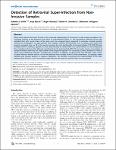Detection of retroviral super-infection from non-invasive samples.
Goffe, Adeelia S.
Blasse, Anja
Mundry, Roger
Leendertz, Fabian
Calvignac, Sébastien
While much attention has been focused on the molecular epidemiology of retroviruses in wild primate populations, the correlated question of the frequency and nature of super-infection events, i.e., the simultaneous infection of the same individual host with several strains of the same virus, has remained largely neglected. In particular, methods possibly allowing the investigation of super-infection from samples collected non-invasively (such as faeces) have never been properly compared. Here, we fill in this gap by assessing the costs and benefits of end-point dilution PCR (EPD-PCR) and multiple bulk-PCR cloning, as applied to a case study focusing on simian foamy virus super-infection in wild chimpanzees (Pan troglodytes). We show that, although considered to be the gold standard, EPD-PCR can lead to massive consumption of biological material when only low copy numbers of the target are expected. This constitutes a serious drawback in a field in which rarity of biological material is a fundamental constraint. In addition, we demonstrate that EPD-PCR results (single/multiple infection; founder strains) can be well predicted from multiple bulk-PCR clone experiments, by applying simple statistical and network analyses to sequence alignments. We therefore recommend the implementation of the latter method when the focus is put on retroviral super-infection and only low retroviral loads are encountered.
No license information

